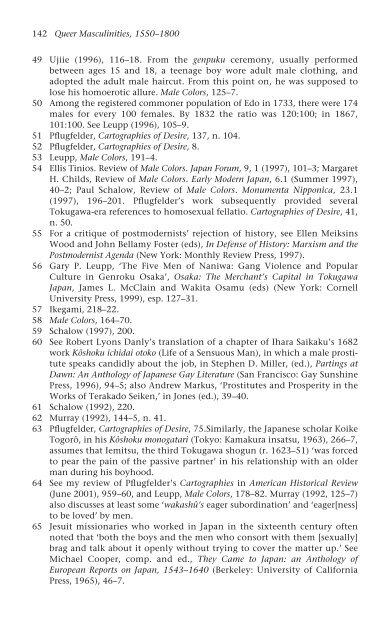queer masculinities
queer masculinities
queer masculinities
You also want an ePaper? Increase the reach of your titles
YUMPU automatically turns print PDFs into web optimized ePapers that Google loves.
142 Queer Masculinities, 1550–1800<br />
49 Ujiie (1996), 116–18. From the genpuku ceremony, usually performed<br />
between ages 15 and 18, a teenage boy wore adult male clothing, and<br />
adopted the adult male haircut. From this point on, he was supposed to<br />
lose his homoerotic allure. Male Colors, 125–7.<br />
50 Among the registered commoner population of Edo in 1733, there were 174<br />
males for every 100 females. By 1832 the ratio was 120:100; in 1867,<br />
101:100. See Leupp (1996), 105–9.<br />
51 Pflugfelder, Cartographies of Desire, 137, n. 104.<br />
52 Pflugfelder, Cartographies of Desire, 8.<br />
53 Leupp, Male Colors, 191–4.<br />
54 Ellis Tinios. Review of Male Colors. Japan Forum, 9, 1 (1997), 101–3; Margaret<br />
H. Childs, Review of Male Colors. Early Modern Japan, 6.1 (Summer 1997),<br />
40–2; Paul Schalow, Review of Male Colors. Monumenta Nipponica, 23.1<br />
(1997), 196–201. Pflugfelder’s work subsequently provided several<br />
Tokugawa-era references to homosexual fellatio. Cartographies of Desire, 41,<br />
n. 50.<br />
55 For a critique of postmodernists’ rejection of history, see Ellen Meiksins<br />
Wood and John Bellamy Foster (eds), In Defense of History: Marxism and the<br />
Postmodernist Agenda (New York: Monthly Review Press, 1997).<br />
56 Gary P. Leupp, ‘The Five Men of Naniwa: Gang Violence and Popular<br />
Culture in Genroku Osaka’, Osaka: The Merchant’s Capital in Tokugawa<br />
Japan, James L. McClain and Wakita Osamu (eds) (New York: Cornell<br />
University Press, 1999), esp. 127–31.<br />
57 Ikegami, 218–22.<br />
58 Male Colors, 164–70.<br />
59 Schalow (1997), 200.<br />
60 See Robert Lyons Danly’s translation of a chapter of Ihara Saikaku’s 1682<br />
work Kôshoku ichidai otoko (Life of a Sensuous Man), in which a male prostitute<br />
speaks candidly about the job, in Stephen D. Miller, (ed.), Partings at<br />
Dawn: An Anthology of Japanese Gay Literature (San Francisco: Gay Sunshine<br />
Press, 1996), 94–5; also Andrew Markus, ‘Prostitutes and Prosperity in the<br />
Works of Terakado Seiken,’ in Jones (ed.), 39–40.<br />
61 Schalow (1992), 220.<br />
62 Murray (1992), 144–5, n. 41.<br />
63 Pflugfelder, Cartographies of Desire, 75.Similarly, the Japanese scholar Koike<br />
Togorô, in his Kôshoku monogatari (Tokyo: Kamakura insatsu, 1963), 266–7,<br />
assumes that Iemitsu, the third Tokugawa shogun (r. 1623–51) ‘was forced<br />
to pear the pain of the passive partner’ in his relationship with an older<br />
man during his boyhood.<br />
64 See my review of Pflugfelder’s Cartographies in American Historical Review<br />
(June 2001), 959–60, and Leupp, Male Colors, 178–82. Murray (1992, 125–7)<br />
also discusses at least some ‘wakashû’s eager subordination’ and ‘eager[ness]<br />
to be loved’ by men.<br />
65 Jesuit missionaries who worked in Japan in the sixteenth century often<br />
noted that ‘both the boys and the men who consort with them [sexually]<br />
brag and talk about it openly without trying to cover the matter up.’ See<br />
Michael Cooper, comp. and ed., They Came to Japan: an Anthology of<br />
European Reports on Japan, 1543–1640 (Berkeley: University of California<br />
Press, 1965), 46–7.


